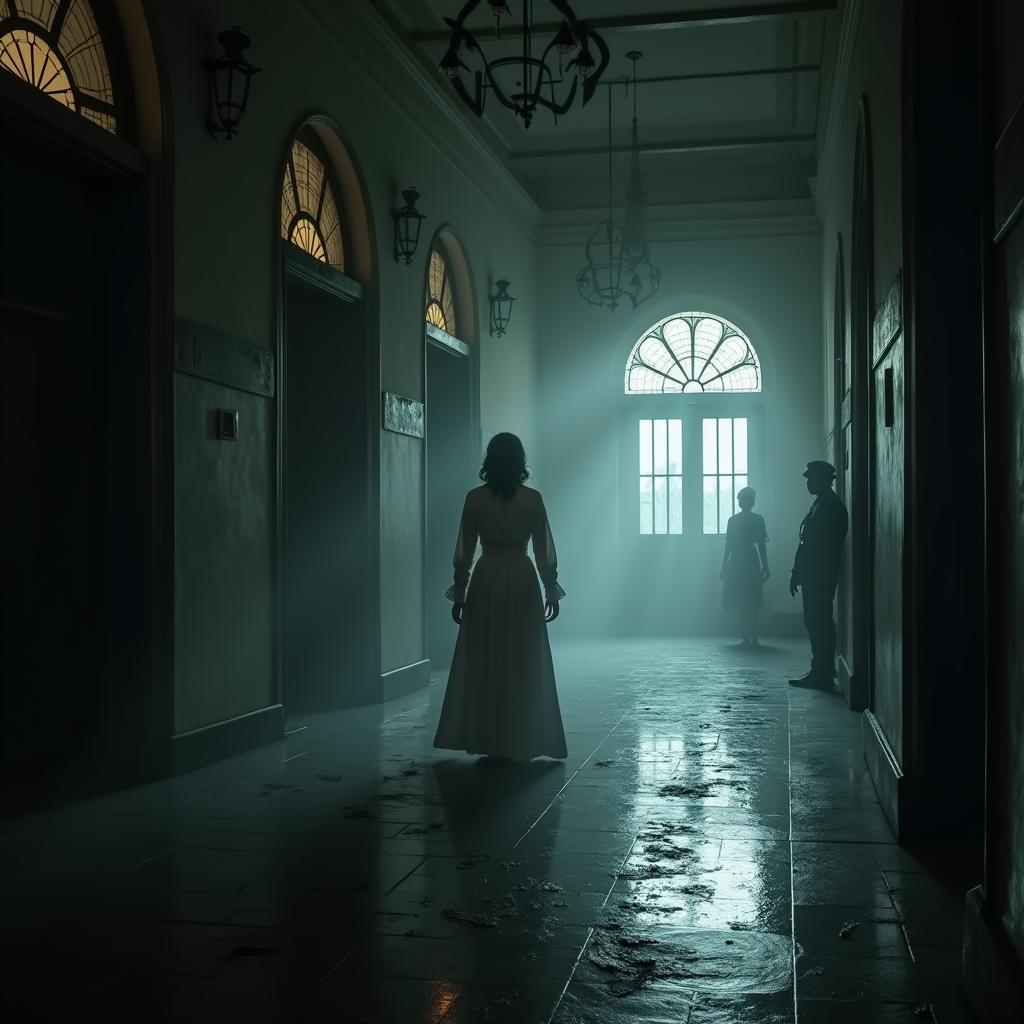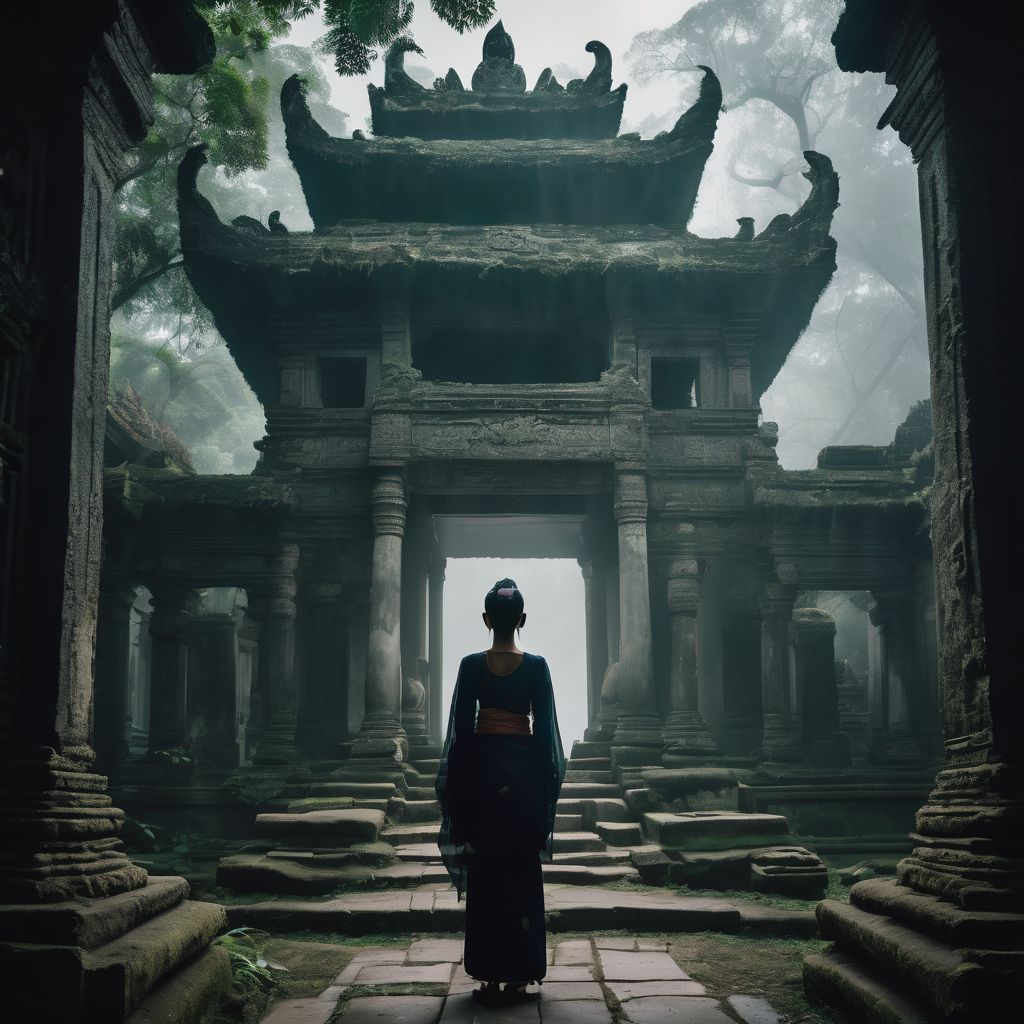The night was unusually quiet when Pak Amir began his security shift at Lawang Sewu, the infamous “Thousand Doors” building in Semarang. Moonlight cascaded through massive stained-glass windows, casting eerie shadows across the expansive corridors of the old Dutch colonial structure. Each step echoed with decades of unspoken history, the building’s white walls holding memories of pain and suffering from a turbulent past.
![attachment"><a href=\'https://relak.la/wp-content/uploads/2025/08/the-echoes-of-history.jpg\'><img loading="lazy" decoding="async" width="300" height="300" src="https://relak.la/wp-content/uploads/2025/08/the-echoes-of-history-300x300.jpg" class="attachment-medium size-medium" alt="" srcset="https://relak.la/wp-content/uploads/2025/08/the-echoes-of-history-300x300.jpg 300w, https://relak.la/wp-content/uploads/2025/08/the-echoes-of-history-150x150.jpg 150w, https://relak.la/wp-content/uploads/2025/08/the-echoes-of-history-768x768.jpg 768w, https://relak.la/wp-content/uploads/2025/08/the-echoes-of-history-420x420.jpg 420w, https://relak.la/wp-content/uploads/2025/08/the-echoes-of-history-696x696.jpg 696w, https://relak.la/wp-content/uploads/2025/08/the-echoes-of-history.jpg 1024w" sizes="auto, (max-width: 300px) 100vw, 300px" /></a></p>\n'}, 'caption': {'raw': '', 'rendered': ''}, 'alt_text': '', 'media_type': 'image', 'mime_type': 'image/jpeg', 'media_details': {'width': 1024, 'height': 1024, 'file': '2025/08/the-echoes-of-history.jpg', 'filesize': 54540, 'sizes': {'medium': {'file': 'the-echoes-of-history-300x300.jpg', 'width': 300, 'height': 300, 'filesize': 7773, 'mime_type': 'image/jpeg', 'source_url': 'https://relak.la/wp-content/uploads/2025/08/the-echoes-of-history-300x300.jpg'}, 'thumbnail': {'file': 'the-echoes-of-history-150x150.jpg', 'width': 150, 'height': 150, 'filesize': 2837, 'mime_type': 'image/jpeg', 'source_url': 'https://relak.la/wp-content/uploads/2025/08/the-echoes-of-history-150x150.jpg'}, 'medium_large': {'file': 'the-echoes-of-history-768x768.jpg', 'width': 768, 'height': 768, 'filesize': 35349, 'mime_type': 'image/jpeg', 'source_url': 'https://relak.la/wp-content/uploads/2025/08/the-echoes-of-history-768x768.jpg'}, 'td_0x420': {'file': 'the-echoes-of-history-420x420.jpg', 'width': 420, 'height': 420, 'filesize': 13300, 'mime_type': 'image/jpeg', 'source_url': 'https://relak.la/wp-content/uploads/2025/08/the-echoes-of-history-420x420.jpg'}, 'td_80x60': {'file': 'the-echoes-of-history-80x60.jpg', 'width': 80, 'height': 60, 'filesize': 1080, 'mime_type': 'image/jpeg', 'source_url': 'https://relak.la/wp-content/uploads/2025/08/the-echoes-of-history-80x60.jpg'}, 'td_150x0': {'file': 'the-echoes-of-history-150x150.jpg', 'width': 150, 'height': 150, 'filesize': 2837, 'mime_type': 'image/jpeg', 'source_url': 'https://relak.la/wp-content/uploads/2025/08/the-echoes-of-history-150x150.jpg'}, 'td_218x150': {'file': 'the-echoes-of-history-218x150.jpg', 'width': 218, 'height': 150, 'filesize': 3681, 'mime_type': 'image/jpeg', 'source_url': 'https://relak.la/wp-content/uploads/2025/08/the-echoes-of-history-218x150.jpg'}, 'td_300x0': {'file': 'the-echoes-of-history-300x300.jpg', 'width': 300, 'height': 300, 'filesize': 7773, 'mime_type': 'image/jpeg', 'source_url': 'https://relak.la/wp-content/uploads/2025/08/the-echoes-of-history-300x300.jpg'}, 'td_324x400': {'file': 'the-echoes-of-history-324x400.jpg', 'width': 324, 'height': 400, 'filesize': 10995, 'mime_type': 'image/jpeg', 'source_url': 'https://relak.la/wp-content/uploads/2025/08/the-echoes-of-history-324x400.jpg'}, 'td_485x360': {'file': 'the-echoes-of-history-485x360.jpg', 'width': 485, 'height': 360, 'filesize': 12927, 'mime_type': 'image/jpeg', 'source_url': 'https://relak.la/wp-content/uploads/2025/08/the-echoes-of-history-485x360.jpg'}, 'td_696x0': {'file': 'the-echoes-of-history-696x696.jpg', 'width': 696, 'height': 696, 'filesize': 30307, 'mime_type': 'image/jpeg', 'source_url': 'https://relak.la/wp-content/uploads/2025/08/the-echoes-of-history-696x696.jpg'}, 'full': {'file': 'the-echoes-of-history.jpg', 'width': 1024, 'height': 1024, 'mime_type': 'image/jpeg', 'source_url': 'https://relak.la/wp-content/uploads/2025/08/the-echoes-of-history.jpg'}}, 'image_meta': {'aperture': '0', 'credit': '', 'camera': '', 'caption': '', 'created_timestamp': '0', 'copyright': '', 'focal_length': '0', 'iso': '0', 'shutter_speed': '0', 'title': '', 'orientation': '0', 'keywords': []}}, 'post': None, 'source_url': 'https://relak.la/wp-content/uploads/2025/08/the-echoes-of-history.jpg', 'missing_image_sizes': [], '_links': {'self': [{'href': 'https://relak.la/wp-json/wp/v2/media/3783', 'targetHints': {'allow': ['GET', 'POST', 'PUT', 'PATCH', 'DELETE']}}], 'collection': [{'href': 'https://relak.la/wp-json/wp/v2/media'}], 'about': [{'href': 'https://relak.la/wp-json/wp/v2/types/attachment'}], 'author': [{'embeddable': True, 'href': 'https://relak.la/wp-json/wp/v2/users/2'}], 'replies': [{'embeddable': True, 'href': 'https://relak.la/wp-json/wp/v2/comments?post=3783'}], 'wp:action-unfiltered-html': [{'href': 'https://relak.la/wp-json/wp/v2/media/3783'}], 'wp:action-assign-author': [{'href': 'https://relak.la/wp-json/wp/v2/media/3783'}], 'curies': [{'name': 'wp', 'href': 'https://api.w.org/{rel}', 'templated': True}]}} "The Echoes of History Pak Amir standing in a dim corridor of Lawang Sewu]({'id': 3783, 'date': '2025-08-17T20:56:09', 'date_gmt': '2025-08-17T12:56:09', 'guid': {'rendered': 'https://relak.la/wp-content/uploads/2025/08/the-echoes-of-history.jpg', 'raw': 'https://relak.la/wp-content/uploads/2025/08/the-echoes-of-history.jpg'}, 'modified': '2025-08-17T20:56:09', 'modified_gmt': '2025-08-17T12:56:09', 'slug': 'the-echoes-of-history', 'status': 'inherit', 'type': 'attachment', 'link': 'https://relak.la/the-echoes-of-history/', 'title': {'raw': 'the-echoes-of-history', 'rendered': 'the-echoes-of-history'}, 'author': 2, 'featured_media': 0, 'comment_status': 'open', 'ping_status': 'closed', 'template': '', 'meta': [], 'permalink_template': 'https://relak.la/?attachment_id=3783', 'generated_slug': 'the-echoes-of-history', 'class_list': ['post-3783', 'attachment', 'type-attachment', 'status-inherit'], 'description': {'raw': '', 'rendered': '<p class=)
Built in 1907 by the Dutch East Indies Railway Company, Lawang Sewu stood as a testament to colonial architecture, its intricate design hiding dark secrets beneath its elegant facade. The building’s basement, once a torture chamber during the Japanese occupation, whispered tales of countless souls who had suffered within its walls. Pak Amir knew the legends – stories passed down through generations about unexplained phenomena and restless spirits that haunted these halls.
![attachment"><a href=\'https://relak.la/wp-content/uploads/2025/08/ghostly-reminders.jpg\'><img loading="lazy" decoding="async" width="300" height="300" src="https://relak.la/wp-content/uploads/2025/08/ghostly-reminders-300x300.jpg" class="attachment-medium size-medium" alt="" srcset="https://relak.la/wp-content/uploads/2025/08/ghostly-reminders-300x300.jpg 300w, https://relak.la/wp-content/uploads/2025/08/ghostly-reminders-150x150.jpg 150w, https://relak.la/wp-content/uploads/2025/08/ghostly-reminders-768x768.jpg 768w, https://relak.la/wp-content/uploads/2025/08/ghostly-reminders-420x420.jpg 420w, https://relak.la/wp-content/uploads/2025/08/ghostly-reminders-696x696.jpg 696w, https://relak.la/wp-content/uploads/2025/08/ghostly-reminders.jpg 1024w" sizes="auto, (max-width: 300px) 100vw, 300px" /></a></p>\n'}, 'caption': {'raw': '', 'rendered': ''}, 'alt_text': '', 'media_type': 'image', 'mime_type': 'image/jpeg', 'media_details': {'width': 1024, 'height': 1024, 'file': '2025/08/ghostly-reminders.jpg', 'filesize': 55422, 'sizes': {'medium': {'file': 'ghostly-reminders-300x300.jpg', 'width': 300, 'height': 300, 'filesize': 9411, 'mime_type': 'image/jpeg', 'source_url': 'https://relak.la/wp-content/uploads/2025/08/ghostly-reminders-300x300.jpg'}, 'thumbnail': {'file': 'ghostly-reminders-150x150.jpg', 'width': 150, 'height': 150, 'filesize': 3457, 'mime_type': 'image/jpeg', 'source_url': 'https://relak.la/wp-content/uploads/2025/08/ghostly-reminders-150x150.jpg'}, 'medium_large': {'file': 'ghostly-reminders-768x768.jpg', 'width': 768, 'height': 768, 'filesize': 39062, 'mime_type': 'image/jpeg', 'source_url': 'https://relak.la/wp-content/uploads/2025/08/ghostly-reminders-768x768.jpg'}, 'td_0x420': {'file': 'ghostly-reminders-420x420.jpg', 'width': 420, 'height': 420, 'filesize': 15628, 'mime_type': 'image/jpeg', 'source_url': 'https://relak.la/wp-content/uploads/2025/08/ghostly-reminders-420x420.jpg'}, 'td_80x60': {'file': 'ghostly-reminders-80x60.jpg', 'width': 80, 'height': 60, 'filesize': 1325, 'mime_type': 'image/jpeg', 'source_url': 'https://relak.la/wp-content/uploads/2025/08/ghostly-reminders-80x60.jpg'}, 'td_150x0': {'file': 'ghostly-reminders-150x150.jpg', 'width': 150, 'height': 150, 'filesize': 3457, 'mime_type': 'image/jpeg', 'source_url': 'https://relak.la/wp-content/uploads/2025/08/ghostly-reminders-150x150.jpg'}, 'td_218x150': {'file': 'ghostly-reminders-218x150.jpg', 'width': 218, 'height': 150, 'filesize': 4907, 'mime_type': 'image/jpeg', 'source_url': 'https://relak.la/wp-content/uploads/2025/08/ghostly-reminders-218x150.jpg'}, 'td_300x0': {'file': 'ghostly-reminders-300x300.jpg', 'width': 300, 'height': 300, 'filesize': 9411, 'mime_type': 'image/jpeg', 'source_url': 'https://relak.la/wp-content/uploads/2025/08/ghostly-reminders-300x300.jpg'}, 'td_324x400': {'file': 'ghostly-reminders-324x400.jpg', 'width': 324, 'height': 400, 'filesize': 12575, 'mime_type': 'image/jpeg', 'source_url': 'https://relak.la/wp-content/uploads/2025/08/ghostly-reminders-324x400.jpg'}, 'td_485x360': {'file': 'ghostly-reminders-485x360.jpg', 'width': 485, 'height': 360, 'filesize': 16644, 'mime_type': 'image/jpeg', 'source_url': 'https://relak.la/wp-content/uploads/2025/08/ghostly-reminders-485x360.jpg'}, 'td_696x0': {'file': 'ghostly-reminders-696x696.jpg', 'width': 696, 'height': 696, 'filesize': 33771, 'mime_type': 'image/jpeg', 'source_url': 'https://relak.la/wp-content/uploads/2025/08/ghostly-reminders-696x696.jpg'}, 'full': {'file': 'ghostly-reminders.jpg', 'width': 1024, 'height': 1024, 'mime_type': 'image/jpeg', 'source_url': 'https://relak.la/wp-content/uploads/2025/08/ghostly-reminders.jpg'}}, 'image_meta': {'aperture': '0', 'credit': '', 'camera': '', 'caption': '', 'created_timestamp': '0', 'copyright': '', 'focal_length': '0', 'iso': '0', 'shutter_speed': '0', 'title': '', 'orientation': '0', 'keywords': []}}, 'post': None, 'source_url': 'https://relak.la/wp-content/uploads/2025/08/ghostly-reminders.jpg', 'missing_image_sizes': [], '_links': {'self': [{'href': 'https://relak.la/wp-json/wp/v2/media/3784', 'targetHints': {'allow': ['GET', 'POST', 'PUT', 'PATCH', 'DELETE']}}], 'collection': [{'href': 'https://relak.la/wp-json/wp/v2/media'}], 'about': [{'href': 'https://relak.la/wp-json/wp/v2/types/attachment'}], 'author': [{'embeddable': True, 'href': 'https://relak.la/wp-json/wp/v2/users/2'}], 'replies': [{'embeddable': True, 'href': 'https://relak.la/wp-json/wp/v2/comments?post=3784'}], 'wp:action-unfiltered-html': [{'href': 'https://relak.la/wp-json/wp/v2/media/3784'}], 'wp:action-assign-author': [{'href': 'https://relak.la/wp-json/wp/v2/media/3784'}], 'curies': [{'name': 'wp', 'href': 'https://api.w.org/{rel}', 'templated': True}]}} "Ghostly Reminders Typewriter keys eerily moving on their own]({'id': 3784, 'date': '2025-08-17T20:56:27', 'date_gmt': '2025-08-17T12:56:27', 'guid': {'rendered': 'https://relak.la/wp-content/uploads/2025/08/ghostly-reminders.jpg', 'raw': 'https://relak.la/wp-content/uploads/2025/08/ghostly-reminders.jpg'}, 'modified': '2025-08-17T20:56:27', 'modified_gmt': '2025-08-17T12:56:27', 'slug': 'ghostly-reminders', 'status': 'inherit', 'type': 'attachment', 'link': 'https://relak.la/ghostly-reminders/', 'title': {'raw': 'ghostly-reminders', 'rendered': 'ghostly-reminders'}, 'author': 2, 'featured_media': 0, 'comment_status': 'open', 'ping_status': 'closed', 'template': '', 'meta': [], 'permalink_template': 'https://relak.la/?attachment_id=3784', 'generated_slug': 'ghostly-reminders', 'class_list': ['post-3784', 'attachment', 'type-attachment', 'status-inherit'], 'description': {'raw': '', 'rendered': '<p class=)
As midnight approached, strange sounds began to fill the empty corridors. The distinct rhythm of typewriter keys echoed from abandoned offices, a ghostly reminder of the building’s administrative past. Footsteps reverberated through the hallways, though Pak Amir knew he was alone in the massive complex. The temperature around him dropped suddenly, sending a chill down his spine – a familiar sign of supernatural presence that local folklore had long warned about.
![attachment"><a href=\'https://relak.la/wp-content/uploads/2025/08/unseen-forces.jpg\'><img loading="lazy" decoding="async" width="300" height="300" src="https://relak.la/wp-content/uploads/2025/08/unseen-forces-300x300.jpg" class="attachment-medium size-medium" alt="" srcset="https://relak.la/wp-content/uploads/2025/08/unseen-forces-300x300.jpg 300w, https://relak.la/wp-content/uploads/2025/08/unseen-forces-150x150.jpg 150w, https://relak.la/wp-content/uploads/2025/08/unseen-forces-768x768.jpg 768w, https://relak.la/wp-content/uploads/2025/08/unseen-forces-420x420.jpg 420w, https://relak.la/wp-content/uploads/2025/08/unseen-forces-696x696.jpg 696w, https://relak.la/wp-content/uploads/2025/08/unseen-forces.jpg 1024w" sizes="auto, (max-width: 300px) 100vw, 300px" /></a></p>\n'}, 'caption': {'raw': '', 'rendered': ''}, 'alt_text': '', 'media_type': 'image', 'mime_type': 'image/jpeg', 'media_details': {'width': 1024, 'height': 1024, 'file': '2025/08/unseen-forces.jpg', 'filesize': 72597, 'sizes': {'medium': {'file': 'unseen-forces-300x300.jpg', 'width': 300, 'height': 300, 'filesize': 9560, 'mime_type': 'image/jpeg', 'source_url': 'https://relak.la/wp-content/uploads/2025/08/unseen-forces-300x300.jpg'}, 'thumbnail': {'file': 'unseen-forces-150x150.jpg', 'width': 150, 'height': 150, 'filesize': 3250, 'mime_type': 'image/jpeg', 'source_url': 'https://relak.la/wp-content/uploads/2025/08/unseen-forces-150x150.jpg'}, 'medium_large': {'file': 'unseen-forces-768x768.jpg', 'width': 768, 'height': 768, 'filesize': 46684, 'mime_type': 'image/jpeg', 'source_url': 'https://relak.la/wp-content/uploads/2025/08/unseen-forces-768x768.jpg'}, 'td_0x420': {'file': 'unseen-forces-420x420.jpg', 'width': 420, 'height': 420, 'filesize': 16680, 'mime_type': 'image/jpeg', 'source_url': 'https://relak.la/wp-content/uploads/2025/08/unseen-forces-420x420.jpg'}, 'td_80x60': {'file': 'unseen-forces-80x60.jpg', 'width': 80, 'height': 60, 'filesize': 1084, 'mime_type': 'image/jpeg', 'source_url': 'https://relak.la/wp-content/uploads/2025/08/unseen-forces-80x60.jpg'}, 'td_150x0': {'file': 'unseen-forces-150x150.jpg', 'width': 150, 'height': 150, 'filesize': 3250, 'mime_type': 'image/jpeg', 'source_url': 'https://relak.la/wp-content/uploads/2025/08/unseen-forces-150x150.jpg'}, 'td_218x150': {'file': 'unseen-forces-218x150.jpg', 'width': 218, 'height': 150, 'filesize': 4136, 'mime_type': 'image/jpeg', 'source_url': 'https://relak.la/wp-content/uploads/2025/08/unseen-forces-218x150.jpg'}, 'td_300x0': {'file': 'unseen-forces-300x300.jpg', 'width': 300, 'height': 300, 'filesize': 9560, 'mime_type': 'image/jpeg', 'source_url': 'https://relak.la/wp-content/uploads/2025/08/unseen-forces-300x300.jpg'}, 'td_324x400': {'file': 'unseen-forces-324x400.jpg', 'width': 324, 'height': 400, 'filesize': 13437, 'mime_type': 'image/jpeg', 'source_url': 'https://relak.la/wp-content/uploads/2025/08/unseen-forces-324x400.jpg'}, 'td_485x360': {'file': 'unseen-forces-485x360.jpg', 'width': 485, 'height': 360, 'filesize': 15164, 'mime_type': 'image/jpeg', 'source_url': 'https://relak.la/wp-content/uploads/2025/08/unseen-forces-485x360.jpg'}, 'td_696x0': {'file': 'unseen-forces-696x696.jpg', 'width': 696, 'height': 696, 'filesize': 39330, 'mime_type': 'image/jpeg', 'source_url': 'https://relak.la/wp-content/uploads/2025/08/unseen-forces-696x696.jpg'}, 'full': {'file': 'unseen-forces.jpg', 'width': 1024, 'height': 1024, 'mime_type': 'image/jpeg', 'source_url': 'https://relak.la/wp-content/uploads/2025/08/unseen-forces.jpg'}}, 'image_meta': {'aperture': '0', 'credit': '', 'camera': '', 'caption': '', 'created_timestamp': '0', 'copyright': '', 'focal_length': '0', 'iso': '0', 'shutter_speed': '0', 'title': '', 'orientation': '0', 'keywords': []}}, 'post': None, 'source_url': 'https://relak.la/wp-content/uploads/2025/08/unseen-forces.jpg', 'missing_image_sizes': [], '_links': {'self': [{'href': 'https://relak.la/wp-json/wp/v2/media/3785', 'targetHints': {'allow': ['GET', 'POST', 'PUT', 'PATCH', 'DELETE']}}], 'collection': [{'href': 'https://relak.la/wp-json/wp/v2/media'}], 'about': [{'href': 'https://relak.la/wp-json/wp/v2/types/attachment'}], 'author': [{'embeddable': True, 'href': 'https://relak.la/wp-json/wp/v2/users/2'}], 'replies': [{'embeddable': True, 'href': 'https://relak.la/wp-json/wp/v2/comments?post=3785'}], 'wp:action-unfiltered-html': [{'href': 'https://relak.la/wp-json/wp/v2/media/3785'}], 'wp:action-assign-author': [{'href': 'https://relak.la/wp-json/wp/v2/media/3785'}], 'curies': [{'name': 'wp', 'href': 'https://api.w.org/{rel}', 'templated': True}]}} "Unseen Forces The old elevator moving with no one inside]({'id': 3785, 'date': '2025-08-17T20:56:47', 'date_gmt': '2025-08-17T12:56:47', 'guid': {'rendered': 'https://relak.la/wp-content/uploads/2025/08/unseen-forces.jpg', 'raw': 'https://relak.la/wp-content/uploads/2025/08/unseen-forces.jpg'}, 'modified': '2025-08-17T20:56:47', 'modified_gmt': '2025-08-17T12:56:47', 'slug': 'unseen-forces-2', 'status': 'inherit', 'type': 'attachment', 'link': 'https://relak.la/unseen-forces-2/', 'title': {'raw': 'unseen-forces', 'rendered': 'unseen-forces'}, 'author': 2, 'featured_media': 0, 'comment_status': 'open', 'ping_status': 'closed', 'template': '', 'meta': [], 'permalink_template': 'https://relak.la/?attachment_id=3785', 'generated_slug': 'unseen-forces-2', 'class_list': ['post-3785', 'attachment', 'type-attachment', 'status-inherit'], 'description': {'raw': '', 'rendered': '<p class=)
Near the old elevator, Pak Amir noticed something extraordinary. The lift began moving between floors without any human intervention, its ancient mechanisms creaking and groaning. Wet footprints appeared mysteriously on the polished floor, leading nowhere and vanishing as quickly as they had materialized. In the corner of his eye, he caught a glimpse of a figure – a Dutch woman in a pristine white period dress, her translucent form floating silently through the corridor.
![attachment"><a href=\'https://relak.la/wp-content/uploads/2025/08/echoes-from-the-past.jpg\'><img loading="lazy" decoding="async" width="300" height="300" src="https://relak.la/wp-content/uploads/2025/08/echoes-from-the-past-300x300.jpg" class="attachment-medium size-medium" alt="" srcset="https://relak.la/wp-content/uploads/2025/08/echoes-from-the-past-300x300.jpg 300w, https://relak.la/wp-content/uploads/2025/08/echoes-from-the-past-150x150.jpg 150w, https://relak.la/wp-content/uploads/2025/08/echoes-from-the-past-768x768.jpg 768w, https://relak.la/wp-content/uploads/2025/08/echoes-from-the-past-420x420.jpg 420w, https://relak.la/wp-content/uploads/2025/08/echoes-from-the-past-696x696.jpg 696w, https://relak.la/wp-content/uploads/2025/08/echoes-from-the-past.jpg 1024w" sizes="auto, (max-width: 300px) 100vw, 300px" /></a></p>\n'}, 'caption': {'raw': '', 'rendered': ''}, 'alt_text': '', 'media_type': 'image', 'mime_type': 'image/jpeg', 'media_details': {'width': 1024, 'height': 1024, 'file': '2025/08/echoes-from-the-past.jpg', 'filesize': 97959, 'sizes': {'medium': {'file': 'echoes-from-the-past-300x300.jpg', 'width': 300, 'height': 300, 'filesize': 10535, 'mime_type': 'image/jpeg', 'source_url': 'https://relak.la/wp-content/uploads/2025/08/echoes-from-the-past-300x300.jpg'}, 'thumbnail': {'file': 'echoes-from-the-past-150x150.jpg', 'width': 150, 'height': 150, 'filesize': 3489, 'mime_type': 'image/jpeg', 'source_url': 'https://relak.la/wp-content/uploads/2025/08/echoes-from-the-past-150x150.jpg'}, 'medium_large': {'file': 'echoes-from-the-past-768x768.jpg', 'width': 768, 'height': 768, 'filesize': 56697, 'mime_type': 'image/jpeg', 'source_url': 'https://relak.la/wp-content/uploads/2025/08/echoes-from-the-past-768x768.jpg'}, 'td_0x420': {'file': 'echoes-from-the-past-420x420.jpg', 'width': 420, 'height': 420, 'filesize': 18526, 'mime_type': 'image/jpeg', 'source_url': 'https://relak.la/wp-content/uploads/2025/08/echoes-from-the-past-420x420.jpg'}, 'td_80x60': {'file': 'echoes-from-the-past-80x60.jpg', 'width': 80, 'height': 60, 'filesize': 1166, 'mime_type': 'image/jpeg', 'source_url': 'https://relak.la/wp-content/uploads/2025/08/echoes-from-the-past-80x60.jpg'}, 'td_150x0': {'file': 'echoes-from-the-past-150x150.jpg', 'width': 150, 'height': 150, 'filesize': 3489, 'mime_type': 'image/jpeg', 'source_url': 'https://relak.la/wp-content/uploads/2025/08/echoes-from-the-past-150x150.jpg'}, 'td_218x150': {'file': 'echoes-from-the-past-218x150.jpg', 'width': 218, 'height': 150, 'filesize': 4343, 'mime_type': 'image/jpeg', 'source_url': 'https://relak.la/wp-content/uploads/2025/08/echoes-from-the-past-218x150.jpg'}, 'td_300x0': {'file': 'echoes-from-the-past-300x300.jpg', 'width': 300, 'height': 300, 'filesize': 10535, 'mime_type': 'image/jpeg', 'source_url': 'https://relak.la/wp-content/uploads/2025/08/echoes-from-the-past-300x300.jpg'}, 'td_324x400': {'file': 'echoes-from-the-past-324x400.jpg', 'width': 324, 'height': 400, 'filesize': 15246, 'mime_type': 'image/jpeg', 'source_url': 'https://relak.la/wp-content/uploads/2025/08/echoes-from-the-past-324x400.jpg'}, 'td_485x360': {'file': 'echoes-from-the-past-485x360.jpg', 'width': 485, 'height': 360, 'filesize': 15762, 'mime_type': 'image/jpeg', 'source_url': 'https://relak.la/wp-content/uploads/2025/08/echoes-from-the-past-485x360.jpg'}, 'td_696x0': {'file': 'echoes-from-the-past-696x696.jpg', 'width': 696, 'height': 696, 'filesize': 46758, 'mime_type': 'image/jpeg', 'source_url': 'https://relak.la/wp-content/uploads/2025/08/echoes-from-the-past-696x696.jpg'}, 'full': {'file': 'echoes-from-the-past.jpg', 'width': 1024, 'height': 1024, 'mime_type': 'image/jpeg', 'source_url': 'https://relak.la/wp-content/uploads/2025/08/echoes-from-the-past.jpg'}}, 'image_meta': {'aperture': '0', 'credit': '', 'camera': '', 'caption': '', 'created_timestamp': '0', 'copyright': '', 'focal_length': '0', 'iso': '0', 'shutter_speed': '0', 'title': '', 'orientation': '0', 'keywords': []}}, 'post': None, 'source_url': 'https://relak.la/wp-content/uploads/2025/08/echoes-from-the-past.jpg', 'missing_image_sizes': [], '_links': {'self': [{'href': 'https://relak.la/wp-json/wp/v2/media/3786', 'targetHints': {'allow': ['GET', 'POST', 'PUT', 'PATCH', 'DELETE']}}], 'collection': [{'href': 'https://relak.la/wp-json/wp/v2/media'}], 'about': [{'href': 'https://relak.la/wp-json/wp/v2/types/attachment'}], 'author': [{'embeddable': True, 'href': 'https://relak.la/wp-json/wp/v2/users/2'}], 'replies': [{'embeddable': True, 'href': 'https://relak.la/wp-json/wp/v2/comments?post=3786'}], 'wp:action-unfiltered-html': [{'href': 'https://relak.la/wp-json/wp/v2/media/3786'}], 'wp:action-assign-author': [{'href': 'https://relak.la/wp-json/wp/v2/media/3786'}], 'curies': [{'name': 'wp', 'href': 'https://api.w.org/{rel}', 'templated': True}]}} "Echoes from the Past The haunting basement filled with shadowy figures]({'id': 3786, 'date': '2025-08-17T20:57:07', 'date_gmt': '2025-08-17T12:57:07', 'guid': {'rendered': 'https://relak.la/wp-content/uploads/2025/08/echoes-from-the-past.jpg', 'raw': 'https://relak.la/wp-content/uploads/2025/08/echoes-from-the-past.jpg'}, 'modified': '2025-08-17T20:57:07', 'modified_gmt': '2025-08-17T12:57:07', 'slug': 'echoes-from-the-past', 'status': 'inherit', 'type': 'attachment', 'link': 'https://relak.la/echoes-from-the-past/', 'title': {'raw': 'echoes-from-the-past', 'rendered': 'echoes-from-the-past'}, 'author': 2, 'featured_media': 0, 'comment_status': 'open', 'ping_status': 'closed', 'template': '', 'meta': [], 'permalink_template': 'https://relak.la/?attachment_id=3786', 'generated_slug': 'echoes-from-the-past', 'class_list': ['post-3786', 'attachment', 'type-attachment', 'status-inherit'], 'description': {'raw': '', 'rendered': '<p class=)
The basement became the epicenter of supernatural activity that night. Haunting screams of prisoners echoed through the underground chambers, a chilling replay of the torturous events that had occurred decades ago. Shadow figures darted between columns, their movements swift and deliberate. Pak Amir found himself trapped, witnessing a spectral reenactment of historical suffering – spirits desperate to share their untold stories of pain and resistance.
![attachment"><a href=\'https://relak.la/wp-content/uploads/2025/08/call-for-protection.jpg\'><img loading="lazy" decoding="async" width="300" height="300" src="https://relak.la/wp-content/uploads/2025/08/call-for-protection-300x300.jpg" class="attachment-medium size-medium" alt="" srcset="https://relak.la/wp-content/uploads/2025/08/call-for-protection-300x300.jpg 300w, https://relak.la/wp-content/uploads/2025/08/call-for-protection-150x150.jpg 150w, https://relak.la/wp-content/uploads/2025/08/call-for-protection-768x768.jpg 768w, https://relak.la/wp-content/uploads/2025/08/call-for-protection-420x420.jpg 420w, https://relak.la/wp-content/uploads/2025/08/call-for-protection-696x696.jpg 696w, https://relak.la/wp-content/uploads/2025/08/call-for-protection.jpg 1024w" sizes="auto, (max-width: 300px) 100vw, 300px" /></a></p>\n'}, 'caption': {'raw': '', 'rendered': ''}, 'alt_text': '', 'media_type': 'image', 'mime_type': 'image/jpeg', 'media_details': {'width': 1024, 'height': 1024, 'file': '2025/08/call-for-protection.jpg', 'filesize': 52554, 'sizes': {'medium': {'file': 'call-for-protection-300x300.jpg', 'width': 300, 'height': 300, 'filesize': 7891, 'mime_type': 'image/jpeg', 'source_url': 'https://relak.la/wp-content/uploads/2025/08/call-for-protection-300x300.jpg'}, 'thumbnail': {'file': 'call-for-protection-150x150.jpg', 'width': 150, 'height': 150, 'filesize': 2957, 'mime_type': 'image/jpeg', 'source_url': 'https://relak.la/wp-content/uploads/2025/08/call-for-protection-150x150.jpg'}, 'medium_large': {'file': 'call-for-protection-768x768.jpg', 'width': 768, 'height': 768, 'filesize': 34759, 'mime_type': 'image/jpeg', 'source_url': 'https://relak.la/wp-content/uploads/2025/08/call-for-protection-768x768.jpg'}, 'td_0x420': {'file': 'call-for-protection-420x420.jpg', 'width': 420, 'height': 420, 'filesize': 13261, 'mime_type': 'image/jpeg', 'source_url': 'https://relak.la/wp-content/uploads/2025/08/call-for-protection-420x420.jpg'}, 'td_80x60': {'file': 'call-for-protection-80x60.jpg', 'width': 80, 'height': 60, 'filesize': 995, 'mime_type': 'image/jpeg', 'source_url': 'https://relak.la/wp-content/uploads/2025/08/call-for-protection-80x60.jpg'}, 'td_150x0': {'file': 'call-for-protection-150x150.jpg', 'width': 150, 'height': 150, 'filesize': 2957, 'mime_type': 'image/jpeg', 'source_url': 'https://relak.la/wp-content/uploads/2025/08/call-for-protection-150x150.jpg'}, 'td_218x150': {'file': 'call-for-protection-218x150.jpg', 'width': 218, 'height': 150, 'filesize': 3092, 'mime_type': 'image/jpeg', 'source_url': 'https://relak.la/wp-content/uploads/2025/08/call-for-protection-218x150.jpg'}, 'td_300x0': {'file': 'call-for-protection-300x300.jpg', 'width': 300, 'height': 300, 'filesize': 7891, 'mime_type': 'image/jpeg', 'source_url': 'https://relak.la/wp-content/uploads/2025/08/call-for-protection-300x300.jpg'}, 'td_324x400': {'file': 'call-for-protection-324x400.jpg', 'width': 324, 'height': 400, 'filesize': 10882, 'mime_type': 'image/jpeg', 'source_url': 'https://relak.la/wp-content/uploads/2025/08/call-for-protection-324x400.jpg'}, 'td_485x360': {'file': 'call-for-protection-485x360.jpg', 'width': 485, 'height': 360, 'filesize': 10304, 'mime_type': 'image/jpeg', 'source_url': 'https://relak.la/wp-content/uploads/2025/08/call-for-protection-485x360.jpg'}, 'td_696x0': {'file': 'call-for-protection-696x696.jpg', 'width': 696, 'height': 696, 'filesize': 29549, 'mime_type': 'image/jpeg', 'source_url': 'https://relak.la/wp-content/uploads/2025/08/call-for-protection-696x696.jpg'}, 'full': {'file': 'call-for-protection.jpg', 'width': 1024, 'height': 1024, 'mime_type': 'image/jpeg', 'source_url': 'https://relak.la/wp-content/uploads/2025/08/call-for-protection.jpg'}}, 'image_meta': {'aperture': '0', 'credit': '', 'camera': '', 'caption': '', 'created_timestamp': '0', 'copyright': '', 'focal_length': '0', 'iso': '0', 'shutter_speed': '0', 'title': '', 'orientation': '0', 'keywords': []}}, 'post': None, 'source_url': 'https://relak.la/wp-content/uploads/2025/08/call-for-protection.jpg', 'missing_image_sizes': [], '_links': {'self': [{'href': 'https://relak.la/wp-json/wp/v2/media/3787', 'targetHints': {'allow': ['GET', 'POST', 'PUT', 'PATCH', 'DELETE']}}], 'collection': [{'href': 'https://relak.la/wp-json/wp/v2/media'}], 'about': [{'href': 'https://relak.la/wp-json/wp/v2/types/attachment'}], 'author': [{'embeddable': True, 'href': 'https://relak.la/wp-json/wp/v2/users/2'}], 'replies': [{'embeddable': True, 'href': 'https://relak.la/wp-json/wp/v2/comments?post=3787'}], 'wp:action-unfiltered-html': [{'href': 'https://relak.la/wp-json/wp/v2/media/3787'}], 'wp:action-assign-author': [{'href': 'https://relak.la/wp-json/wp/v2/media/3787'}], 'curies': [{'name': 'wp', 'href': 'https://api.w.org/{rel}', 'templated': True}]}} "Call for Protection Pak Amir reciting prayers in the dim light]({'id': 3787, 'date': '2025-08-17T20:57:26', 'date_gmt': '2025-08-17T12:57:26', 'guid': {'rendered': 'https://relak.la/wp-content/uploads/2025/08/call-for-protection.jpg', 'raw': 'https://relak.la/wp-content/uploads/2025/08/call-for-protection.jpg'}, 'modified': '2025-08-17T20:57:26', 'modified_gmt': '2025-08-17T12:57:26', 'slug': 'call-for-protection', 'status': 'inherit', 'type': 'attachment', 'link': 'https://relak.la/call-for-protection/', 'title': {'raw': 'call-for-protection', 'rendered': 'call-for-protection'}, 'author': 2, 'featured_media': 0, 'comment_status': 'open', 'ping_status': 'closed', 'template': '', 'meta': [], 'permalink_template': 'https://relak.la/?attachment_id=3787', 'generated_slug': 'call-for-protection', 'class_list': ['post-3787', 'attachment', 'type-attachment', 'status-inherit'], 'description': {'raw': '', 'rendered': '<p class=)
Realizing the gravity of his situation, Pak Amir began reciting Islamic prayers, a protective measure deeply rooted in local spiritual traditions. The spirits seemed to respond to his invocation, their intense energy gradually dissipating as dawn’s first light approached. His colleague, hearing his distressed calls, rushed to his aid, finding Pak Amir with visible scratches and a look of profound shock etched across his face.
![attachment"><a href=\'https://relak.la/wp-content/uploads/2025/08/the-aftermath.jpg\'><img loading="lazy" decoding="async" width="300" height="300" src="https://relak.la/wp-content/uploads/2025/08/the-aftermath-300x300.jpg" class="attachment-medium size-medium" alt="" srcset="https://relak.la/wp-content/uploads/2025/08/the-aftermath-300x300.jpg 300w, https://relak.la/wp-content/uploads/2025/08/the-aftermath-150x150.jpg 150w, https://relak.la/wp-content/uploads/2025/08/the-aftermath-768x768.jpg 768w, https://relak.la/wp-content/uploads/2025/08/the-aftermath-420x420.jpg 420w, https://relak.la/wp-content/uploads/2025/08/the-aftermath-696x696.jpg 696w, https://relak.la/wp-content/uploads/2025/08/the-aftermath.jpg 1024w" sizes="auto, (max-width: 300px) 100vw, 300px" /></a></p>\n'}, 'caption': {'raw': '', 'rendered': ''}, 'alt_text': '', 'media_type': 'image', 'mime_type': 'image/jpeg', 'media_details': {'width': 1024, 'height': 1024, 'file': '2025/08/the-aftermath.jpg', 'filesize': 94243, 'sizes': {'medium': {'file': 'the-aftermath-300x300.jpg', 'width': 300, 'height': 300, 'filesize': 11449, 'mime_type': 'image/jpeg', 'source_url': 'https://relak.la/wp-content/uploads/2025/08/the-aftermath-300x300.jpg'}, 'thumbnail': {'file': 'the-aftermath-150x150.jpg', 'width': 150, 'height': 150, 'filesize': 3937, 'mime_type': 'image/jpeg', 'source_url': 'https://relak.la/wp-content/uploads/2025/08/the-aftermath-150x150.jpg'}, 'medium_large': {'file': 'the-aftermath-768x768.jpg', 'width': 768, 'height': 768, 'filesize': 58014, 'mime_type': 'image/jpeg', 'source_url': 'https://relak.la/wp-content/uploads/2025/08/the-aftermath-768x768.jpg'}, 'td_0x420': {'file': 'the-aftermath-420x420.jpg', 'width': 420, 'height': 420, 'filesize': 19895, 'mime_type': 'image/jpeg', 'source_url': 'https://relak.la/wp-content/uploads/2025/08/the-aftermath-420x420.jpg'}, 'td_80x60': {'file': 'the-aftermath-80x60.jpg', 'width': 80, 'height': 60, 'filesize': 1149, 'mime_type': 'image/jpeg', 'source_url': 'https://relak.la/wp-content/uploads/2025/08/the-aftermath-80x60.jpg'}, 'td_150x0': {'file': 'the-aftermath-150x150.jpg', 'width': 150, 'height': 150, 'filesize': 3937, 'mime_type': 'image/jpeg', 'source_url': 'https://relak.la/wp-content/uploads/2025/08/the-aftermath-150x150.jpg'}, 'td_218x150': {'file': 'the-aftermath-218x150.jpg', 'width': 218, 'height': 150, 'filesize': 4036, 'mime_type': 'image/jpeg', 'source_url': 'https://relak.la/wp-content/uploads/2025/08/the-aftermath-218x150.jpg'}, 'td_300x0': {'file': 'the-aftermath-300x300.jpg', 'width': 300, 'height': 300, 'filesize': 11449, 'mime_type': 'image/jpeg', 'source_url': 'https://relak.la/wp-content/uploads/2025/08/the-aftermath-300x300.jpg'}, 'td_324x400': {'file': 'the-aftermath-324x400.jpg', 'width': 324, 'height': 400, 'filesize': 16090, 'mime_type': 'image/jpeg', 'source_url': 'https://relak.la/wp-content/uploads/2025/08/the-aftermath-324x400.jpg'}, 'td_485x360': {'file': 'the-aftermath-485x360.jpg', 'width': 485, 'height': 360, 'filesize': 14307, 'mime_type': 'image/jpeg', 'source_url': 'https://relak.la/wp-content/uploads/2025/08/the-aftermath-485x360.jpg'}, 'td_696x0': {'file': 'the-aftermath-696x696.jpg', 'width': 696, 'height': 696, 'filesize': 48428, 'mime_type': 'image/jpeg', 'source_url': 'https://relak.la/wp-content/uploads/2025/08/the-aftermath-696x696.jpg'}, 'full': {'file': 'the-aftermath.jpg', 'width': 1024, 'height': 1024, 'mime_type': 'image/jpeg', 'source_url': 'https://relak.la/wp-content/uploads/2025/08/the-aftermath.jpg'}}, 'image_meta': {'aperture': '0', 'credit': '', 'camera': '', 'caption': '', 'created_timestamp': '0', 'copyright': '', 'focal_length': '0', 'iso': '0', 'shutter_speed': '0', 'title': '', 'orientation': '0', 'keywords': []}}, 'post': None, 'source_url': 'https://relak.la/wp-content/uploads/2025/08/the-aftermath.jpg', 'missing_image_sizes': [], '_links': {'self': [{'href': 'https://relak.la/wp-json/wp/v2/media/3788', 'targetHints': {'allow': ['GET', 'POST', 'PUT', 'PATCH', 'DELETE']}}], 'collection': [{'href': 'https://relak.la/wp-json/wp/v2/media'}], 'about': [{'href': 'https://relak.la/wp-json/wp/v2/types/attachment'}], 'author': [{'embeddable': True, 'href': 'https://relak.la/wp-json/wp/v2/users/2'}], 'replies': [{'embeddable': True, 'href': 'https://relak.la/wp-json/wp/v2/comments?post=3788'}], 'wp:action-unfiltered-html': [{'href': 'https://relak.la/wp-json/wp/v2/media/3788'}], 'wp:action-assign-author': [{'href': 'https://relak.la/wp-json/wp/v2/media/3788'}], 'curies': [{'name': 'wp', 'href': 'https://api.w.org/{rel}', 'templated': True}]}} "The Aftermath Morning light revealing strange markings on the walls]({'id': 3788, 'date': '2025-08-17T20:57:46', 'date_gmt': '2025-08-17T12:57:46', 'guid': {'rendered': 'https://relak.la/wp-content/uploads/2025/08/the-aftermath.jpg', 'raw': 'https://relak.la/wp-content/uploads/2025/08/the-aftermath.jpg'}, 'modified': '2025-08-17T20:57:46', 'modified_gmt': '2025-08-17T12:57:46', 'slug': 'the-aftermath', 'status': 'inherit', 'type': 'attachment', 'link': 'https://relak.la/the-aftermath/', 'title': {'raw': 'the-aftermath', 'rendered': 'the-aftermath'}, 'author': 2, 'featured_media': 0, 'comment_status': 'open', 'ping_status': 'closed', 'template': '', 'meta': [], 'permalink_template': 'https://relak.la/?attachment_id=3788', 'generated_slug': 'the-aftermath', 'class_list': ['post-3788', 'attachment', 'type-attachment', 'status-inherit'], 'description': {'raw': '', 'rendered': '<p class=)
The morning revealed physical evidence of the night’s supernatural encounter – unexplained marks on the walls, displaced objects, and an overwhelming sense of lingering spiritual energy. Lawang Sewu continued to stand as a powerful reminder of Indonesia’s complex historical narrative, its haunting legacy preserved within its thousand doors and countless windows. Local beliefs emphasized respect for these spirits, understanding them as echoes of a painful past seeking acknowledgment.
Horror Level:
4 / 5
Categories: Asian Horror, Colonial History, Ghost Stories, Ghost Stories, Historical Hauntings, Personal Encounters
Tags: colonial history, ghost stories, haunted buildings, Historical Hauntings, Indonesian Folklore, Lawang Sewu, security guard stories, Supernatural Encounters
Religion: Islam
Country of Origin: Indonesia
Topic: Historical Haunting
Ethnicity: Indonesian


